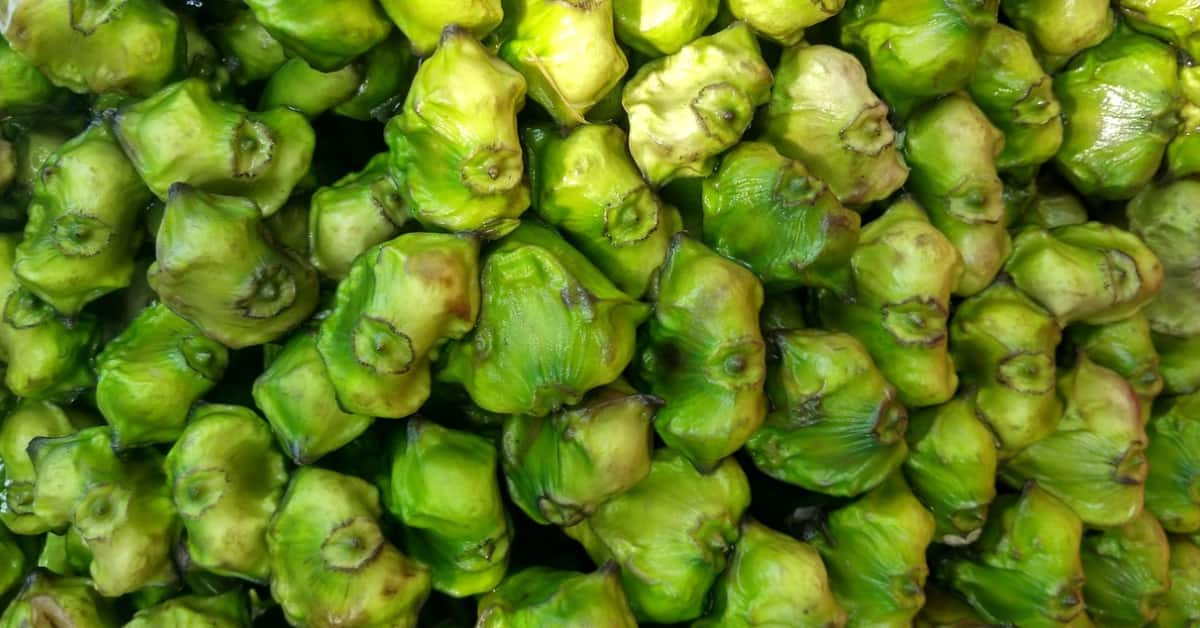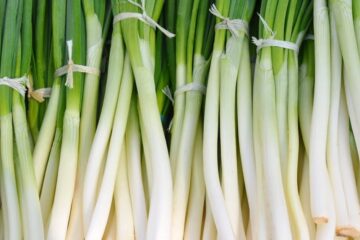Table of Contents
Introduction
Water Chestnut (known in India as Singhara or Paniphal) is an aquatic tuber vegetable (Trapa natans or Eleocharis dulcis) cultivated in the shallow, muddy waters of ponds, lakes, and paddy fields across Asia and Africa for at least 3,000 years. Unlike tree nuts, the singhara is a low-calorie, zero-fat vegetable highly valued for its crisp, white flesh and rich nutritional profile, which includes significant amounts of dietary fiber, Potassium, manganese, and antioxidants.
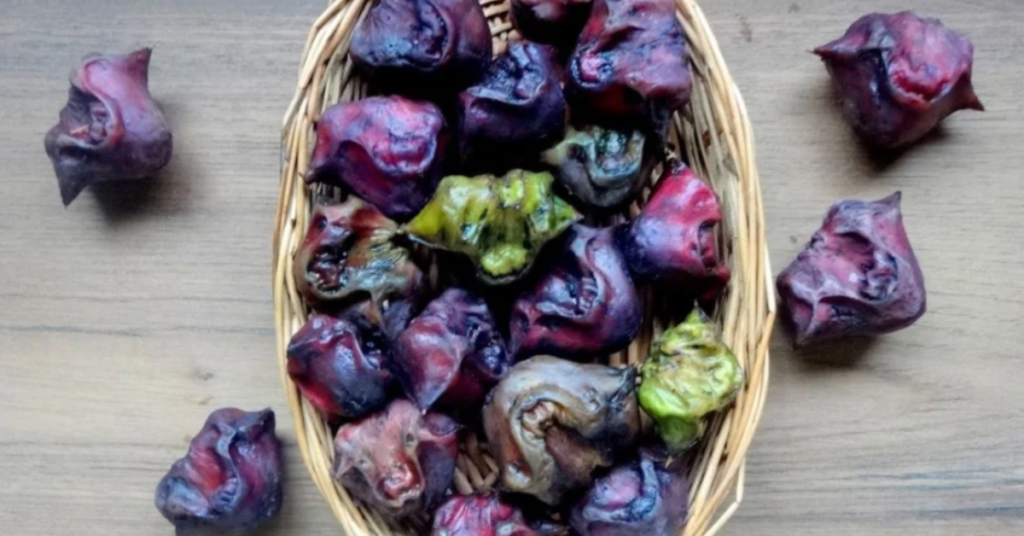
Water chestnut
Despite being named chestnuts, they are not nuts. They are aquatic tuber vegetables that develop or grow in marshes, shallow lakes, paddy fields, and ponds.
Water chestnuts are native to Southeast China, Southern Asia, Taiwan, Australia, Africa, and so many islands in the Pacific and Indian oceans.
They are harvested when the bulb, or corm, turns dark brown.
They have crisp, white flesh that can be enjoyed raw or cooked. They are a common addition to Asian dishes, stir-fries, chop suey, curries, & salads.
Furthermore, water chestnuts (Eleocharis dulcis) should not be confused with water caltrops (Trapa natans), which are also often named water chestnuts. Water caltrops are shaped as bats or buffalo heads and taste similar to yams or potatoes.
They have many uses and offer several benefits. Here are five science-backed advantages of water chestnuts, plus ideas for how to eat them.
Nutrition and Calories
They are high in fiber, low in calories, and they contain no fat. They also have several vitamins and healthy antioxidants.
They are an excellent source of:
- Vitamin B6
- Riboflavin
- Potassium
- Manganese
- Copper
Raw water chestnut nutrients per serving
A 2/3 cup serving (100 grams) of raw, sliced water chestnuts contains:
- Calories: 97
- Fat: 0 grams
- Carbohydrates: 24 grams
- Protein: 1 gram
- Fiber: 3 grams
- Sugar: 5 grams
- Potassium: 584 mg
Canned water chestnut nutrients per serving
A 2/3 cup serving (100 grams) of canned, sliced water chestnuts contains:
- Calories: 29
- Protein: 0.7 grams
- Fat: 0 grams
- Carbohydrates: 7 grams
- Fiber: 2 grams
- Sugar: 3 grams
- Potassium: 200 mg
Note on Canned vs. Fresh: Canned chestnuts typically have much lower nutritional value and calorie counts (sometimes ∼30 kcal per 100g) because the canning process can leach out some water-soluble vitamins and minerals. Fresh or singhara flour (atta) offers the highest nutritional benefits.
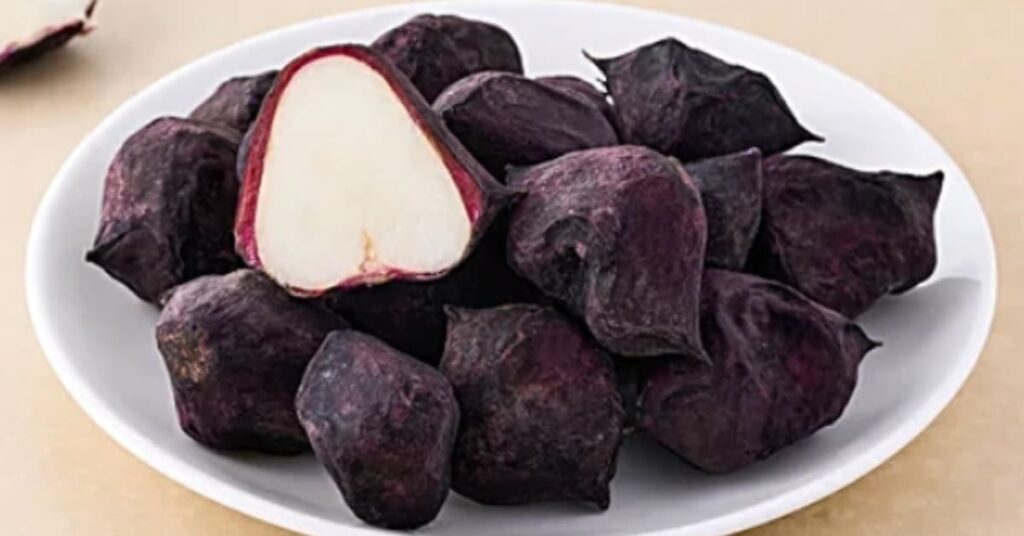
Water chestnut benefits
Here are 15 key health benefits of consuming it:
Cardiovascular & Metabolic Health
1. Lowers Blood Pressure (High Potassium):
They are exceptionally high in Potassium (∼584 mg per 100g), which helps counteract the effects of sodium, relax blood vessels, and manage hypertension.
2. Reduces Risk of Stroke:
High potassium intake is directly linked to a significantly reduced chance of stroke and other cardiovascular events.
3. Supports Heart Health:
Being virtually fat-free and low in sodium, their fiber & potassium content help lower LDL (“bad”) cholesterol, promoting overall heart health.
4. Aids Blood Sugar Regulation:
The high dietary fiber content slows carbohydrate absorption, assisting in preventing sharp blood sugar spikes & supporting better glucose control.
5. Improves Insulin Sensitivity:
The fiber and bioactive compounds help reduce insulin resistance, making cells more efficient at glucose uptake.
Antioxidant & Cellular Protection
6. Rich in Disease-Fighting Antioxidants:
They are an important source of antioxidants, particularly ferulic acid, flavonoids, and polyphenols.
7. Fights Oxidative Stress:
These antioxidants neutralize free radicals, mitigating or alleviating oxidative stress & decreasing the risk of chronic diseases, for example, heart disease and Type 2 diabetes.
8. Potential Anticancer Properties:
Studies suggest that antioxidants like ferulic acid may help inhibit the growth of specific tumor cells and reduce the risk of several cancers (preclinical research).
9. Anti-inflammatory Effects:
Compounds in water chestnuts help repair damaged cells and reduce chronic inflammation throughout the body.
Digestive, Weight, and Energy Benefits
10. Aids Weight Management (Low Calorie/High Volume):
Being over 70% water and high in fiber, they are high-volume foods that provide great satiety (fullness) with very few calories.
11. Excellent for Hydration:
Their high water content offers natural hydration and a traditional “cooling” effect on the body, especially during hot weather.
12. Promotes Digestive Health:
The high fiber content is crucial for regulating bowel movements, preventing constipation, & supporting a healthy gut microbiome.
13. Good Source of Energy:
The carbohydrates are predominantly starch, providing a steady release of energy without the abrupt spikes caused by simple sugars.
Other Specialized Benefits
1 4.Gluten-Free Staple:
When dried and ground into flour (Singhara atta), it serves as a critical, gluten-free substitute for wheat flour, particularly for those with gluten sensitivities or during fasting rituals.
15. Uplifts Mood and Combats Fatigue:
Water chestnuts are an important source of Vitamin B6, that is vital for neurotransmitter function, helping to reduce stress, uplift mood, & combat physical fatigue.

Water chestnut plant
The term “water chestnut plant” in everyday use refers to two distinct aquatic species, both cultivated for their edible, starchy core:
- The Water Caltrop (Trapa natans or Singhara): This is the species most commonly grown and consumed in India and Southeast Asia.
- Description: It is an annual, free-floating plant rooted in the mud of shallow ponds and slow-moving rivers. It has two kinds of leaves: finely divided submerged leaves and floating, triangular or rhomboid leaves arranged in a rosette on the water’s surface, supported by spongy, inflated stems.
- Fruit: It produces a hard, woody, nut-like fruit (the Singhara) that is distinctively shaped, often having two or four sharp, spiky horns (hence the name “devil pod” or “bat nut” in some regions). The edible white kernel inside is starchy and sweet.
- The Chinese Water Chestnut (Eleocharis dulcis): This is the variety most commonly used in canned form and found in international stir-fries.
- Description: It is a grass-like sedge that produces tall, leafless, cylindrical green stems (culms).
- Edible Part: The edible part is not the fruit, but a small, rounded, bulb-like corm that grows underground in the mud.
Both plants thrive in warm, nutrient-rich, freshwater environments and produce an edible white interior that remains crunchy even after cooking (due to the presence of ferulic acid).
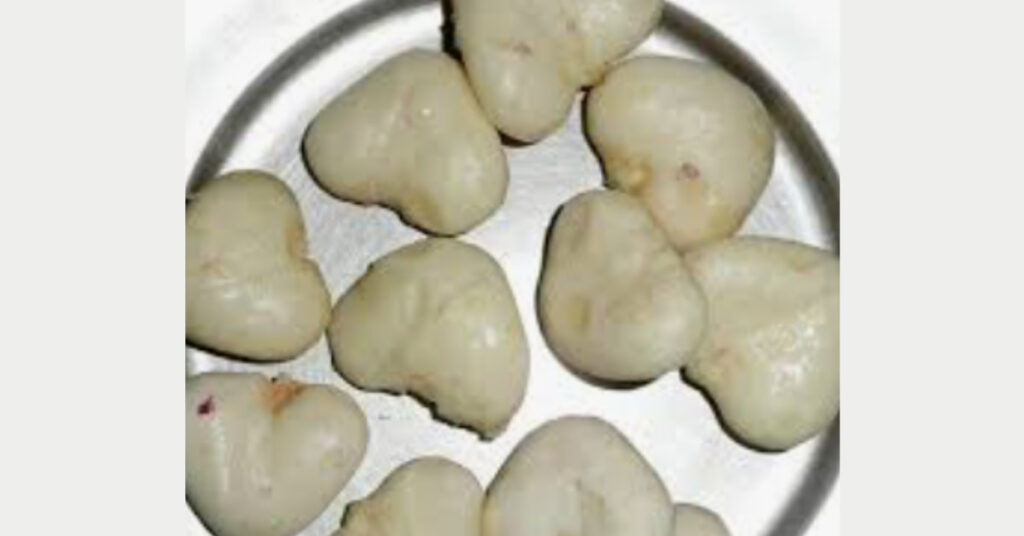
Water chestnut flour
Its flour, known in India as Singhara Atta, is a highly significant food product derived from the edible kernels of the water chestnut (Trapa natans) after they are dried and finely ground.
Here is a summary of its composition and uses:
- Nutritional Profile: It is a non-cereal, gluten-free flour that is notably rich in complex carbohydrates (making it an excellent source of quick energy), dietary fiber, and essential minerals such as potassium, Manganese, and Calcium. It is also naturally low in fat.
- Cultural Importance (Vrat/Fasting): In Indian cuisine, Singhara Atta is critical because it is the main flour (Vrat Ka Atta) utilized during Hindu fasts (such as Navratri & Maha Shivratri). During these periods, devotees abstain from flours derived from cereal grains (like wheat), making Singhara Atta the primary base for preparing unleavened flatbreads (rotis), puris, and savory pancakes (cheelas).
- Health Benefits: Its high fiber content supports digestion and helps regulate blood sugar absorption. Because it is naturally gluten-free, it is an ideal and nutritious alternative for individuals with celiac disease or gluten sensitivities.
- Culinary Use: Beyond fasting, it is often used as a thickening agent in Asian sauces and as a batter for deep-frying, imparting a desirable, light, and crisp texture.
Recipe
You can eat this raw, boiled, grilled, pickled, or canned.
The corms are unique because they remain crisp even after cooking or canning, thanks to their high ferulic acid content.
Water chestnuts are popular in Chinese cooking. In the U.S., one of the most common dishes prepared with water chestnuts is American-Chinese chop suey.
Water chestnut recipes
Here are some ways you can use water chestnuts in recipes:
- Stir-fry: Steam water chestnuts and add them to a stir-fry with spicy meats or savory greens.
- Lettuce wraps or egg rolls: Use water chestnuts as a filling with other vegetables.
- Soup: Make a water chestnut and pork ribs soup.
- Side dish: Sauté water chestnuts with green beans and ginger.
- Appetizer: Wrap water chestnuts in bacon and bake until crispy.
- Salad topping: Add water chestnuts to chicken or tuna salads for added crunchiness.
- Snack: Enjoy water chestnuts plain, pickled, or candied.
- Dessert: Make a Thai “Red Rubies” dessert, featuring water chestnuts dyed red and coconut cream.
- Baked goods: Dry water chestnuts and grind them into a thickening agent or flour.
Conclusion
Water chestnuts are native to Southeast China, Southern Asia, Taiwan, Australia, Africa, and so many islands in the Pacific and Indian oceans.
They are harvested when the bulb, or corm, turns dark brown.
They have crisp, white flesh that can be enjoyed raw or cooked. They are a common addition to Asian dishes, stir-fries, chop suey, curries, & salads.
Furthermore, water chestnuts (Eleocharis dulcis) should not be confused with water caltrops (Trapa natans), which are also often named water chestnuts. Water caltrops are shaped as bats or buffalo heads and taste similar to yams or potatoes.

